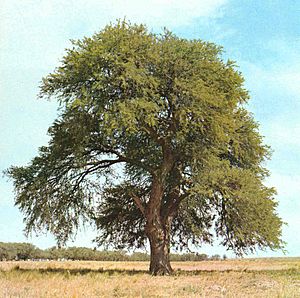Prosopis facts for kids
Quick facts for kids Prosopis |
|
|---|---|
 |
|
| Prosopis caldenia, a species of central Argentina. | |
| Scientific classification |
|
| Kingdom: | Plantae |
| Clade: | Tracheophytes |
| Clade: | Angiosperms |
| Clade: | Eudicots |
| Clade: | Rosids |
| Order: | Fabales |
| Family: | Fabaceae |
| Subfamily: | Caesalpinioideae |
| Clade: | Mimosoideae |
| Genus: | Prosopis L. |
| Type species | |
| Prosopis spicigera L.
|
|
| Species | |
|
See text |
|
| Synonyms | |
|
|
Prosopis is a group of around 45 types of flowering plants. They are mostly trees and shrubs that have spines. You can find them in warm, dry areas around the world, like parts of the Americas, Africa, and Asia. These plants are super tough! They often grow well in dry soil and can handle drought (long periods without rain). Some Prosopis trees have incredibly deep roots to find water. Their wood is usually very hard and strong. The fruits of Prosopis are pods, which can be quite sweet. The name Prosopis comes from an old Greek word meaning "burdock".
Contents
Different Types of Prosopis Plants
There are many different species of Prosopis found in various parts of the world. Here are some of the main groups:
Mesquite Trees: Found in the Americas
These Prosopis species are common in the southern United States and Mexico.
- Prosopis glandulosa – This is known as honey mesquite.
- Prosopis laevigata – Also called smooth mesquite.
- Prosopis pubescens – This one is called screwbean mesquite because its pods are twisted like a screw.
- Prosopis velutina – Known as velvet mesquite.
Algarrobos and Bayahondas: From the Neotropics
These types are found in the Neotropics, especially in a region called the Gran Chaco.
- Prosopis alba – Known as algarrobo blanco, meaning "white carob tree."
- Prosopis caldenia – Called caldén.
- Prosopis chilensis – Known as algarrobo Chileno.
- Prosopis juliflora – This one is called bayahonda blanca.
- Prosopis nigra – Known as algarrobo negro, meaning "black carob tree."
- Prosopis tamarugo – This tree is called tamarugo.
African Prosopis Species
- Prosopis africana – This species is known as gele in the Malinke language. Its wood is traditionally used to make djembe drums.
Asian Prosopis Species
These are found in parts of India, Sri Lanka, and the Arabian Peninsula.
- Prosopis cineraria – Known as jand or ghaf. It's an important tree in desert areas.
How Scientists Classify Prosopis
Scientists are always learning new things about plants through research. Recent studies from 2022 suggest that the plants we call Prosopis might actually belong to several different groups, not just one. This means that the way these plants are grouped together might change in the future as we learn more!
Prosopis as an Invasive Species
While many Prosopis species are native and important in their homes, some have been moved to new places by people. When they grow in new areas, they can sometimes become an invasive species. This means they spread quickly and cause problems for the local environment and economy.
For example, Prosopis pallida was brought to Hawaii in 1828. Now, it grows all over the dry coastal parts of the islands. It's called the kiawe tree there and is a main source of special monofloral honey.
In Australia, some Prosopis species are causing big problems.
- They have sharp thorns and many low branches. This makes them form thick, thorny bushes that are hard to get through.
- These thickets can stop farm animals, like cattle, from reaching water sources.
- They also take over valuable grasslands where animals graze and suck up the little water available.
- Prosopis can even cause land erosion because they push out native plants and animals.
- These dense bushes also provide hiding places for wild animals like pigs and cats, which can harm native wildlife.
For more details on how mesquite species can be invasive, you can look up Prosopis glandulosa and Prosopis juliflora.
Controlling Prosopis Spread
Getting rid of invasive Prosopis can be very hard.
- The plant can grow back even from a small piece of root left in the soil. Its special growing part can be as deep as 6 inches (150 mm) underground.
- Some plant-killing chemicals (called herbicides) don't work well or only partly work against Prosopis.
- Spraying to remove them can be expensive.
- Removing large trees often needs heavy machinery, which can cost a lot of money.
- In Australia, people use different methods to try and control Prosopis plants.
See also
 In Spanish: Prosopis para niños
In Spanish: Prosopis para niños

